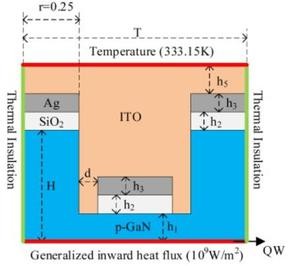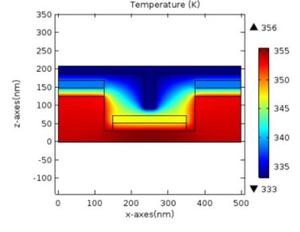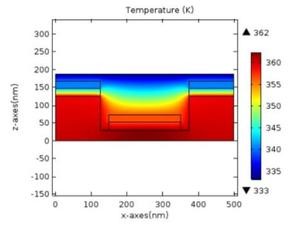Light emitting diodes (LEDs) have the advantages of low power consumption, small size, long service life, good modulation performance, short response time and others, and can realize the lighting and communication functions simultaneously. However, due to the existence of the total reflection and the heat accumulation inside GaN layer, the modulation bandwidth of the current LED is still not high, which greatly affects the transmission rate of visible light communication (VLC) system. Once the size of the LED reaches its limit, the RC time constant cannot be further reduced, and the modulation bandwidth will be mainly limited by the carrier recombination lifetime. The carrier recombination lifetime decreases as the injection current density increases, but the increasing of the injection current density is limited by the heat dissipation conditions of LED.
The heat in the LED device is mainly dissipated by heat conduction. Diamond is one of the best heat dissipation materials in nature and its heat dissipation coefficient can be as high as 2200W/m.k, which is much larger than the heat dissipation coefficient of GaN and metal Ag. At the same time, its performance is very stable and has high light transmission. The introduction of the diamond wafer structure into the LED does not seriously affect the emission efficiency, and can greatly increase the heat dissipation performance of the device. Therefore, the use of the diamond heat sink will solve the problem of the temperature rise and the efficiency drop of LED under the high injection current density, so that the injection current density of LED can be greatly improved, and the carrier recombination lifetime is drastically decreased, thereby further increasing the modulation bandwidth.

Fig. 1. Simulation diagram of the heat dissipation model (a) with diamond (b) without diamond.
The heat transfer module of the COMSOL software is used to build a heat dissipation model of the novel structure, and a heat dissipation model of the structure without diamond is built for comparison. The heat dissipation models of the novel structure and the structure without diamond are shown in Fig. 1a and b, respectively. The size parameters of the heat dissipation model adopt the previously optimized parameters, that is, T = 500 nm, H = 125 nm, h1 = 30 nm, h2 = 23 nm, h3 = 20 nm, h4 = 20 nm, h5 = 20 nm, h6 = 20 nm, L = 30 nm, d = 25 nm, r = 0.25. We set a generalized inward heat flux at the bottom of p-GaN with a magnitude of 109Wm−2, and a temperature boundary at the top of diamond layer or ITO layer with a magnitude of 333.15 K, and thermal insulation boundary conditions on both sides of the novel structure and the structure without diamond.


Fig. 2. Temperature distribution of the heat dissipation model (a) with diamond (b) without diamond.
Since the generalized inward heat flux at the bottom of the two structures is the same and the temperature at the top is the same, the different heat dissipation performance will affect the temperature distribution inside the model. The temperature distributions of the two models are shown in Fig. 2a and b, respectively. As can be seen from Fig. 2 that the maximum temperatures of the novel structure and the structure without diamond are 356 K and 362 K, respectively, which indicates that the heat dissipation performance of the novel structure are better than that of the structure without diamond. In Fig. 2a, the temperature of diamond and its surrounding area is about 335 K, while the temperature is only about 335 K on the upper layer of ITO in Fig. 2b, so we can clearly see the improvement of the heat dissipation performance using the diamond. The improvement of the heat dissipation performance will help to increase the upper limit of the injection current density of LED, which can increase the carrier concentration and reduce the carrier recombination lifetime, thus increasing the modulation bandwidth of LED.
In summary, the diamond wafer structure can effectively increase the heat dissipation performance of the device, and the carrier recombination lifetime can be reduced by increasing the injection current density of LED, thereby increasing the modulation bandwidth. The simulation results show that the IQE and heat dissipation performance of the novel LED can be effectively improved, providing a new method for the development of high bandwidth GaN-based LEDs.
CSMH focuses on the R&D and production of diamond. After more than ten years of technology accumulation, the technical indicators of the existing diamond heat sink and l diamond wafer products have reached the world's leading level, and the surface roughness of the diamond wafer growth surface Ra<1nm , the thermal conductivity of the diamond heat sink is 1000-2000W/m.K. High-power semiconductor lasers using diamond heat sinks have been used in optical communications, and are also used in high-power LEDs, power transistors, and electronic packaging materials.
 闽ICP备2021005558号-1
闽ICP备2021005558号-1Leave A Message